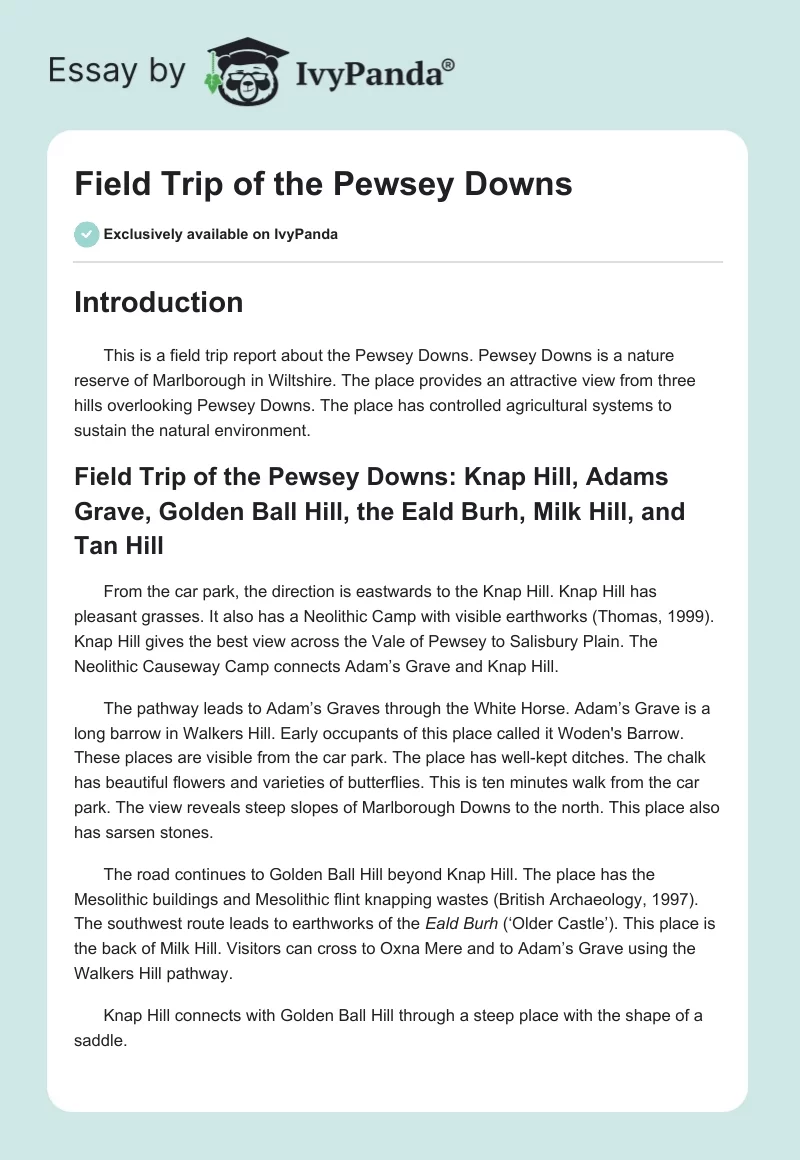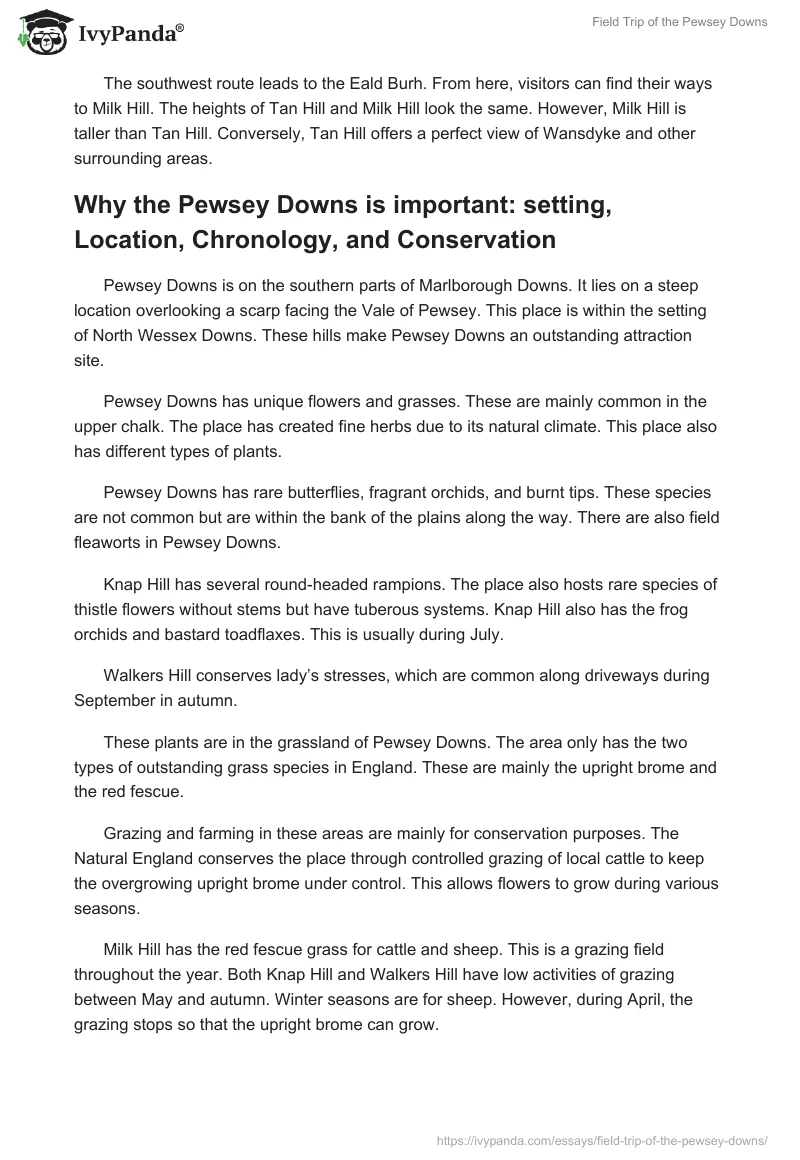Introduction
This is a field trip report about the Pewsey Downs. Pewsey Downs is a nature reserve of Marlborough in Wiltshire. The place provides an attractive view from three hills overlooking Pewsey Downs. The place has controlled agricultural systems to sustain the natural environment.
Field Trip of the Pewsey Downs: Knap Hill, Adams Grave, Golden Ball Hill, the Eald Burh, Milk Hill, and Tan Hill
From the car park, the direction is eastwards to the Knap Hill. Knap Hill has pleasant grasses. It also has a Neolithic Camp with visible earthworks (Thomas, 1999). Knap Hill gives the best view across the Vale of Pewsey to Salisbury Plain. The Neolithic Causeway Camp connects Adam’s Grave and Knap Hill.
The pathway leads to Adam’s Graves through the White Horse. Adam’s Grave is a long barrow in Walkers Hill. Early occupants of this place called it Woden’s Barrow. These places are visible from the car park. The place has well-kept ditches. The chalk has beautiful flowers and varieties of butterflies. This is ten minutes walk from the car park. The view reveals steep slopes of Marlborough Downs to the north. This place also has sarsen stones.
The road continues to Golden Ball Hill beyond Knap Hill. The place has the Mesolithic buildings and Mesolithic flint knapping wastes (British Archaeology, 1997). The southwest route leads to earthworks of the Eald Burh (‘Older Castle’). This place is the back of Milk Hill. Visitors can cross to Oxna Mere and to Adam’s Grave using the Walkers Hill pathway.
Knap Hill connects with Golden Ball Hill through a steep place with the shape of a saddle.
The southwest route leads to the Eald Burh. From here, visitors can find their ways to Milk Hill. The heights of Tan Hill and Milk Hill look the same. However, Milk Hill is taller than Tan Hill. Conversely, Tan Hill offers a perfect view of Wansdyke and other surrounding areas.
Why the Pewsey Downs is important: setting, Location, Chronology, and Conservation
Pewsey Downs is on the southern parts of Marlborough Downs. It lies on a steep location overlooking a scarp facing the Vale of Pewsey. This place is within the setting of North Wessex Downs. These hills make Pewsey Downs an outstanding attraction site.
Pewsey Downs has unique flowers and grasses. These are mainly common in the upper chalk. The place has created fine herbs due to its natural climate. This place also has different types of plants.
Pewsey Downs has rare butterflies, fragrant orchids, and burnt tips. These species are not common but are within the bank of the plains along the way. There are also field fleaworts in Pewsey Downs.
Knap Hill has several round-headed rampions. The place also hosts rare species of thistle flowers without stems but have tuberous systems. Knap Hill also has the frog orchids and bastard toadflaxes. This is usually during July.
Walkers Hill conserves lady’s stresses, which are common along driveways during September in autumn.
These plants are in the grassland of Pewsey Downs. The area only has the two types of outstanding grass species in England. These are mainly the upright brome and the red fescue.
Grazing and farming in these areas are mainly for conservation purposes. The Natural England conserves the place through controlled grazing of local cattle to keep the overgrowing upright brome under control. This allows flowers to grow during various seasons.
Milk Hill has the red fescue grass for cattle and sheep. This is a grazing field throughout the year. Both Knap Hill and Walkers Hill have low activities of grazing between May and autumn. Winter seasons are for sheep. However, during April, the grazing stops so that the upright brome can grow.
The planned grazing has ensured that these fields have the best conditions for animals, varieties of plants, and other types of insects found on these plains. Pewsey Downs has unique butterflies, which conservation efforts aim at protecting. There are skippers, wall browns, and green hairstreaks during early periods of spring. During late summer, there are chalk-hill blue butterflies. In addition, there are also rare varieties of marsh fritillaries, dark green fritillaries, and small coppers and marbled white fritillaries (Natural England, 2007).
Pewsey Downs also has rabbits, moles, and badger. These animals create conducive environments for coexisting in the park in different ways.
Chronology and Own Interpretation
Pewsey Downs has rich archaeological features dating back to 1812. The White Horse makes the place noticeable. Students have used Golden Ball Hill for their geological classes.
Between 1966 and 1970, there were major excavations in Pewsey Downs. The excavations at SU 117648 and SU 193665 revealed Roman artefacts. This showed that there were elements of post-Roman activities in the area (Fowler, 2000; Draper, 2006). During excavation for water pipes in 1997, excavators did not discover any artefact along the existing Causeway running to West Wansdyke. The excavation revealed that the soil was of a modern formation (Anon, 1999).
According to a study by Maud Cunnington, excavations of 1909 and 1910 at the Causeway Enclosure revealed some activities archaeologists did not discuss earlier. As a result, Cunnington believed that the Causeway Enclosure was Neolithic (Cunnington, 1909). This was a period before the age of radiocarbon dating. Cunnington based her argument on the remains of pottery and features of the Causeway. She found bones of domesticated pigs and ox, and a pottery currently called the Windmill Hill.
In 1961, Graham Connah adopted the Cunnington’s method of excavation (Connah, 1969). However, he used advanced techniques together with methodical approaches. He also had high standards of recording and applied radiocarbon dating to evaluate his discoveries. Connah confirmed the discoveries of Cunnington regarding domesticated ox in a Neolithic setting. However, the study did not draw conclusions on the bones of pigs, sheep, and goats (Connah, 1965). This was because the stratigraphy remained unclear.
Pewsey Downs also presents periods misunderstood in history (Tubb, 2011). According to Tubb, most people do not understand prehistoric activities in the Vale of Pewsey in Wiltshire. Therefore, understanding of prehistoric activities in Pewsey Downs requires “a combination of archival reassessment, aerial photographic interpretation and non-intrusive fieldwork” (Tubb, 2011).
According to Connah, it is difficult to classify the origin of artefact at Pewsey Downs. However, he shows that the Causeway of Knap Hill did not receive many activities during the prehistoric occupation (Connah, 1965). At the same time, it is difficult to know what activities went on at Knap Hill. However, interpretation shows there was a meeting point at a flint. Still, it is difficult to establish significant activities, which took place there.
In the recent studies, Tubb shows that the “Vale was the location for a considerable density of Late Bronze Age and Early Iron Age sites” (Tubb, 2011).
Reference List
Anon, R 1999, ‘Excavation and Fieldwork in Wiltshire’, The Wiltshire Archaeological and Natural History Magazine, vol. 92, pp. 133-143.
British Archaeology 1997, ‘Three Mesolithic houses discovered near Avebury’, British Archaeology, no. 28, p. 1.
Connah, G 1965, ‘Excavations at Knap Hill, Alton Priors’, The Wiltshire Archaeological and Natural History Magazine, vol. 60, no. 1, pp. 1-23.
Connah, G 1969, ‘Radiocarbon dating for Knap Hill’, Antiquity, vol. 43, no. 172, pp. 304-305.
Cunnington, M 1909, ‘On a Remarkable Feature in the Entrenchments of Knap Hill Camp, Wiltshire’, Man, vol. 9, pp. 49–52.
Draper, S 2006, Landscape, Settlement and Society in Roman and early Mediaeval Wiltshire, Archaeopress, BAR British Series, Oxford.
Fowler, P 2000, East Wansdyke, Red Shore and New Buildings, Alton and Savernake. Web.
Natural England 2007, Pewsey Downs: National Nature Reserve, Natural England, Wiltshire.
Thomas, J 1999, Understanding the Neolithic, 2nd edn, Routledge, Oxford.
Tubb, P 2011, The LBA/EIA Transition in the Vale of Pewsey, Hadrian Books, Oxford.


